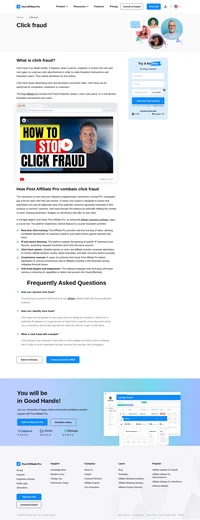Affiliate marketing comes with several benefits
For businesses, it’s an excellent method to build a following around your brand for a low cost. And since you pay only when you see visible results of your marketers’ work, the risk of losing money on it should be low. Your marketers are also motivated to work hard because the more people click on their links, the more money they will get. And what’s even better, their video channel or blog can earn them money while sleeping or being on holiday.
Not everyone wants to spend their time creating content or interacting with their audience, though. Unfortunately, some marketers are looking for a quick buck at the expense of affiliate program owners. In one piece of research on affiliate fraud cases, CHEQ and the University of Baltimore found that affiliate marketing fraud cost advertisers $1.4 billion in 2020 alone!
That’s why securing your own program from dishonest marketers and cybercriminals should be a priority. But do you know what exactly affiliate fraud is and how to prevent it from hurting your program? If not, stay tuned – in a moment, we’ll discuss what affiliate fraud is, how to spot suspicious activity in your program, and how you can protect it from cybercriminals.
What is affiliate fraud?
Affiliate fraud is any deceptive, misleading behavior that does not follow your program’s rules. Whether it’s using illegally gained user data to create new leads, taking credit for purchases made with counterfeit credit cards, or employing bots to boost clicks or traffic. All of those actions have one thing in common – the fraudster responsible wants to earn as much as possible in the short window they have before getting caught.
To know how you can stop them in their tracks, first, you need to understand what fraudulent methods are the “most popular” among criminals.

How do cybercriminals commit fraud?
What is incredibly worrying now is that affiliate fraudsters have several tricks up their sleeves thanks to new tools. What’s more, they keep finding new ways to scam companies out of their money. But most of these cyber criminals still use either one or more of the “tried and tested” fraudulent methods. So let’s have a look at some of them.
Using bots to create fake traffic or clicks
In 2020, 37.2% of all internet user activity was made by bots, with 20% being malicious. Tiny programs called bots can mimic real users’ behavior to generate fake clicks, followers, or even leads. A great example of this is on social media platforms, where some influencers buy followers to increase engagement and likes. These tactics were all designed to make it seem as if there were hundreds of clicks on their affiliate links. There are even bots that can fill out lead generation forms and submit them as well as download and use apps!
And since the owners of such bots make sure to hide their location and activities, it might take a while for a company to notice they are losing money on worthless traffic or clicks.
Faking location using VPN
Virtual private networks (VPNs) and proxies are widely used by cybercriminals as a way to hide their tracks. There are other reasons as well – some affiliates may use VPNs to send traffic from countries that pay better. Commission rates vary by country depending on which affiliate company receives the traffic. As a result, fraudsters will often exploit it.
With a VPN and various VPN protocols, a fraudulent marketer can mislead a company into thinking that they have new visitors from the countries they are most interested in and pay the referring affiliates accordingly – the problem being that those visitors do not actually exist.
Misleading content or incentives
You have no doubt come across a YouTube video where the thumbnail or description promised far more than the It’s likely you have encountered a YouTube video with a very tempting thumbnail but not great content or an ad with a very tempting offer that, once you clicked on the website, was not worth clicking on.
The fraudsters aren’t interested in the actual content of the video or website, as long as they get people to click on the ad or video. A click will still be paid even if the visitor leaves the page shortly afterwards.
But fraudsters can get even more insidious and lure people into purchasing products or completing specific actions, promising them exclusive rewards. And obviously, they won’t ever be seen by the victims. Once they realize that they have been scammed, they will likely demand refunds from the affiliate program owners. But business owners may not even know what methods their affiliates used to drive the purchases in the first place!
Cookie stuffing
How does an affiliate program owner know whether or not an affiliate fulfilled the conditions to earn commission? By tracking cookies (tiny text files in an internet’s user browser that websites can read). In theory, they allow program owners to reward exactly the affiliates who deserve it. But if an affiliate fraudster uses a cookie stuffing method, they are instead rewarded for bringing traffic to the program.
How does it work? Through a website, pop-up, or browser extension, the fraudsters drop one or more third-party cookies into a visitor’s web browser. If a user happens to visit one of the sites from which the cookie originates and makes a purchase, the cookie will mislead the advertiser into thinking that lead was brought by the fraudster.
What’s even worse is that the dropped cookies can override those coming from legitimate affiliates, allowing fraudsters to take credit for someone else’s hard work. In this case, your affiliates may earn far less, which could result in them abandoning your program.

How to find out whether you have been a victim of affiliate fraud?
An occurrence of affiliate fraud can be obvious in hindsight – if you call a lead and only get an angry “where do you have my number from?” reply, or you notice there are some suspicious failed sales in your records, for example. But what other things happening in your program should raise a red flag?
- You don’t see any actual activity inside your app, or it stops suddenly. If you have hundreds of app installs, but there’s little to no activity within it, then there’s a chance that the installations are mostly coming from bots. If you notice any suspicious activity patterns (such as the app being uninstalled multiple times after exactly the same number of days), then you can be almost sure that bots are responsible.
- Suspiciously good results of one or more of your affiliates. You surely have top performers in your program that bring the most traffic or sales to your page. However, if they seem to hit all campaign goals in a much shorter time than their peers, or have a much higher conversion rate than your average, you ought to take a closer look at them.
- You’re getting a ton of traffic, but no conversions – thousands of clicks or app installs might seem like a sign that a campaign is doing well, but so-called vanity metrics can be easily manipulated and so you shouldn’t focus only on those. Instead, it’s a good idea to always compare the number of clicks or views related to conversion or the number of active leads. If they don’t match, then something is amiss.
- There’s a sudden increase in refunds or chargeback demands. Some affiliate fraudsters might go as far as to fake sales with stolen credit card data to earn commission. Once you reward them, you might find out that the payment for their sale didn’t go through or that you receive a demand for a chargeback. If you have only one or two such issues, then there’s no need to worry, but several and in a short time or coming from the same affiliate? You should investigate this immediately.
How can you stop affiliate fraud from harming your business?
Stopping affiliate fraudsters in their tracks might sound like a pretty tricky thing to do, especially when they keep on coming up with new methods and tools. But there’s a couple of things you can do to make sure your program is safe.
The first is to vet your potential affiliates before hiring them. Besides having an active blog or video channel where they publish regularly, a legitimate affiliate should also match your brand and your products. Let’s suppose there’s something that raises suspicion, such as their social media account being very young but already having thousands of followers. In that case, you should take a closer look at the affiliate to reduce the risk of hiring a fraudster.
In the event they pass the initial screening, you will need to inform them of your terms and conditions, including actions that violate your program’s rules and how you will handle such violations. Likewise, if you already have affiliates working for you, keep an eye on their activity and results. It’s a good idea to ask questions rather than let things settle on their own if something seems suspicious.
Try as you might, though; it’s unlikely that you’ll be able to keep track of everything – especially if you have several marketers to take care of. So here’s where Post Affiliate Pro can help to protect your affiliate program further from any suspicious activity. The platform can monitor all actions and transactions generated in your program and automatically block all suspicious behavior like multiple clicks, sign-ups, or duplicate orders and then decline commissions accordingly.
In the meantime, you can create a blacklist of suspicious IP addresses and regions to protect your program against bots. It is strongly recommended that you block all traffic coming from countries with high bot traffic rates. That way, Post Affiliate Pro doesn’t count any actions that come from those locations. As well as protecting you from loss of money on illegally earned commission fees, this will also keep your metrics clear since unreliable data resulting from suspicious behavior won’t affect them.
Conclusion
Fraud attempts of any kind are harmful both to program owners, affiliates, and regular people as well. Besides hurting them financially, fraud also damages people’s trust in the industry and might also scare them away from trying affiliate marketing. But the good news is that you have plenty of ways to protect your online business from fraudsters and affiliate scammers. The more you know about their methods, the greater the chance you’ll avoid having any trouble with fraudsters.
Post Affiliate Pro is ready to help with securing your program as well. So if you want to talk about how you can use our platform to protect your affiliate program, why not reach out to us?
Frequently Asked Questions
How does affiliate fraud work?
Affiliate fraud involves deceptive tactics to generate fake conversions and earn commissions from affiliate marketing programs. Methods include fake leads, click fraud, and cookie stuffing, making it seem like genuine traffic and conversions occurred, resulting in unearned commissions for the affiliate marketer.
How can affiliate marketing prevent fraud?
Affiliate marketing can prevent fraud by implementing robust tracking and monitoring systems to ensure that all conversions and sales are legitimate. This can include using fraud detection tools, tracking IP addresses and user behavior, and setting up strict verification processes for affiliates and customers. Additionally, regularly monitoring and auditing affiliate activities can help to identify and prevent any fraudulent behavior before it impacts the business.
What is an example of affiliate fraud?
An example of affiliate fraud is when an affiliate intentionally manipulates or inflates the number of clicks, leads, or sales in order to receive higher commission payments from the advertiser. This can be done through various fraudulent methods such as using automated bots, fake accounts, or misleading advertising tactics.
How does affiliate fraud work?
Affiliate fraud involves deceptive tactics to generate fake conversions and earn commissions from affiliate marketing programs. Methods include fake leads, click fraud, and cookie stuffing, making it seem like genuine traffic and conversions occurred, resulting in unearned commissions for the affiliate marketer.
How can affiliate marketing prevent fraud?
Affiliate marketing can prevent fraud by implementing robust tracking and monitoring systems to ensure that all conversions and sales are legitimate. This can include using fraud detection tools, tracking IP addresses and user behavior, and setting up strict verification processes for affiliates and customers. Additionally, regularly monitoring and auditing affiliate activities can help to identify and prevent any fraudulent behavior before it impacts the business.
What is an example of affiliate fraud?
An example of affiliate fraud is when an affiliate intentionally manipulates or inflates the number of clicks, leads, or sales in order to receive higher commission payments from the advertiser. This can be done through various fraudulent methods such as using automated bots, fake accounts, or misleading advertising tactics.
Share this article
The leader in Affiliate software
Post Affiliate Pro offers a comprehensive affiliate software platform to manage multiple affiliate programs with ease. Enjoy no setup fees, 24/7 customer support, and a free 1-month trial. Ideal for small and large businesses, it features precise tracking, automated workflows, and customizable tools to boost your affiliate marketing success. Try it now and streamline your affiliate operations effortlessly!
8 affiliate marketing scams to avoid in 2025
Discover the top 8 affiliate marketing scams to avoid in 2023 with Post Affiliate Pro. Learn how to spot tactics like fake products, get-rich-quick schemes, and more. Stay informed to protect your business and reputation from fraudulent activities in this booming industry.
How Affiliate Marketing Works [Explained]
Discover how affiliate marketing can boost your income in 2023 with Post Affiliate Pro's detailed video guide. Learn the strategies to earn commissions by promoting products through reviews, and leverage buyer intent keywords to attract potential customers. Perfect for anyone looking to understand the workings of affiliate marketing and maximize their earning potential.
The 7 most common affiliate marketing questions answered
Discover the answers to the 7 most common affiliate marketing questions with our comprehensive guide! Learn how to get started, choose the right niche, and find reputable programs. Whether you're a beginner or looking to boost your affiliate earnings, this resource will guide you toward success in the affiliate marketing world. Visit now to unlock the potential of affiliate marketing!
Discover the essential role of affiliate software in managing and optimizing your affiliate marketing programs. Learn how it streamlines link tracking, referral management, and commission payments, ensuring data security and fraud prevention. Unlock growth opportunities with efficient program management and boost your business's reach and ROI. Visit now to explore the benefits of investing in affiliate software!













